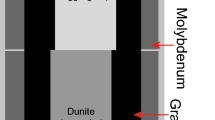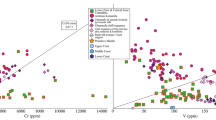Abstract
The Mount Stuart batholith is a Late Cretaceous calc-alkaline pluton composed of rocks ranging in composition from two-pyroxene gabbro to granite. Quartz diorite is most abundant. This batholith may represent the plutonic counterpart of the high-alumina basalt association. A petrogenetic model is developed in which this intrusive series evolved from one batch of magnesian high-alumina basalt, represented by the oldest intrusive phase, by successive crystal fractionation of ascending residual magma. However, the possibility that this intrusive suite originated from an andésite (quartz diorite) parent by fractionation cannot be excluded.
Computer modeling of this intrusive sequence provides a quantitative evaluation of the sequential change of magma composition. These calculations clearly indicate that the igneous suite is consanguineous, and that subtraction of early-formed crystals from the oldest rock is capable of reproducing the entire magma series with a remainder of 2–3% granitic liquid. This model requires that large amounts of gabbroic cumulate remain hidden at depth- an amount equal to approximately 8−10X the volume of the exposed batholith. Mass balances between the amounts of cumulate and residual liquid calculated compare favorably with the observed amounts of intermediate rocks exposed in the batholith, but not with the mafic rocks.
Mafic magmas probably fractionated at depth by crystal settling, whereas younger quartz diorite and more granitic magmas underwent inward crystallization producing gradationally zoned plutons exposed at present erosional levels.
Similar content being viewed by others
References
Pratt, R.M.: The geology of the Mount Stuart area, Washington. Unpublished Ph.D. dissertation, Univ. Washington, 219 p. (1958)
Russell, I.C.: A preliminary paper on the geology of the Cascade Mountains. U.S. Geol. Surv. 20th Ann. Rpt. Pt. 2, 83–210 (1900)
Smith, G.O.: Description of the Mount Stuart Quadrangle, U.S. Geol. Surv. Atlas, 106, Mount Stuart Folio, 10 p. (1904)
Huntting, M.T., Bennett, W.G., Livingston, Jr., V.E., Moen, W.S.: Geologic map of Washington. Washington State Div. Mines Geol., Olympia 1961
Misch, P.: Tectonic evolution of the northern Cascades of Washington State-a west Cordilleran case history. In: Can. Inst. Min. Metal. Spec. Vol. 8, 101–148 (1966)
Page, B.M.: Geology of part of the Chiwaukum Quadrangle, Washington. Unpublished Ph.D. dissertation, Stanford Univ., 203 p. (1939)
Plummer, C.C.: Geology of the crystalline rocks, Chiwaukum Mtns., and vicinity, Washington Cascades. Unpublished Ph.D. disseration, Univ. Washington, 137 p. (1969)
Frost, B.R.: Contact metamorphism of serpentinite, chlorite blackwell and rodingite at Paddy-Go Easy Pass, central Cascades, Washington. J. Petrol. 16, 272–313 (1975)
Southwick, D.L.: Geology of the Alpine-type ultramafic complex near Mt. Stuart, Washington. Geol. Soc. Am. Bull. 85, 391–402 (1974)
Vance, J.A.: Geology of the Sauk River area, north Cascades. Unpublished Ph.D. dissertation, Univ. Washington (1957)
Yeats, R.S.: Geology of the Skykomish area in the Cascade Mountains of Washington. Unpublished Ph.D. dissertation, Univ. Washington, 243 p. (1958)
Willis, C.L.: The Chiwaukum graben, a major structure of central Washington. Am. J. Sci. 251, 789–797 (1953)
Shapiro, L.: Rapid analysis of rocks and minerals by a single solution method. U.S. Geol. Surv. Profess. Papers 557-B, 187–191B (1967)
Medlin, J.H., Suhr, N.H., Bodkin, J.B.: Atomic absorption analysis of silicates employing LiBO2 fusion. Atomic Abs. Newsletter 8, 25–29 (1969)
Mutschler, F.E., Rougon, D.R., Lavin, O.P.: PETROS, a data bank of major element chemical analyses of igneous rocks for research and teaching. Computers Geosci., in press (1976)
Flanagan, F.J.: U.S. Geological Survey silicate rock standards. Geochim. Cosmochim. Acta 31, 289–308 (1967)
Chayes, F.: Petrographic modal analysis. 113 p. New York: John Wiley 1956
Pongsapich, W.: Geology of the eastern part of the Mt. Stuart batholith, central Cascades, Washington. Unpublished Ph.D. dissertation, Univ. Washington, 170 p. (1974)
Engels, J.C., Crowder, D.F.: Late Cretaceous fission-track and potassium argon ages of the Mount Stuart granodiorite and Beckler Peak stock, North Cascades, Washington. U.S. Geol. Surv. Profess. Papers 750-D, 39–43D (1972)
Erikson, E.H., Williams, A.: Implications of apatite fission track ages in the Mount Stuart batholith, Cascade Mountains, Washington (abst.). Geol. Soc. Am. Programs, Cordilleran Sec. Mtgs. 8, p. 372 (1976)
Yeats, R.S., McLaughlin, W.A.: Radiometrie age of three Cascade plutons, Skykomish area, Washington (abst.). Geol. Soc. Am. Program Ann. Mtg., Mexico City, p. 332 (1968)
Yeats, R.S., Engels, J.C.: Potassium-argon ages of plutons in the Skykomish-Stillaguamish areas, North Cascades, Washington. U.S. Geol. Surv. Profess. Papers 750-D, 34–38D (1972)
Erikson, E.H.: Degranitization of the Late Cretaceous Mount Stuart batholith, central Cascades, Washington (abst). Geol. Soc. Am. Abs. Programs 5, p. 39 (1973)
Holdaway, M.J.: Stability of andalusite and the aluminum silicate phase diagram. Am. J. Sci. 271, 97–131 (1971)
Richardson, S.W.: Staurolite stability in a part of the system Fe-Al-Si-O-H. J. Petrol. 9, 467–489 (1968)
Althaus, E., Karothe, E., Nitsch, K.H., Winkler, H.G.F.: An experimental reexamination of the upper stability limit of muscovite plus quartz. Neues Jahrb. Mineral. 7, 289–336 (1970)
Irvine, T.N., Baragar, W.R.A.: A guide to the chemical classification of the common volcanic rocks. Can. J. Earth Sci. 8, 523–548 (1971)
Bateman, P.C., Clark, L.D., Huber, N.K., Moore, J.G., Rinehart, C.D.: The Sierra Nevada batholith, a recent synthesis across the central part. U.S. Geol. Surv. Profess. Papers 414-D, 46 p. (1963)
Erikson, E.H.: Petrology of the composite Snoqualmie batholith, central Cascades, Washington. Geol. Soc. Am. Bull. 80, 2213–2236 (1969)
Larsen, E.S.: Batholith and associated rocks of Corona, Elsinore, and San Luis Rey Quadrangles, southern California. Geol. Soc. Am. Mem. 29, 182 p. (1948)
Nockolds, S.R., Allen, R.: The geochemistry of some igneous rock series. Geochim. Cosmochim. Acta, 4, 105–142 (1953)
Bowen, N.L.: The evolution of igneous rocks. 332 p. New York: Dover 1956
Kuno, H.: Origin of Cenozoic petrographie provinces of Japan and surrounding areas. Volc. Bull. 20, Ser. 2, 37–76 (1959)
Kuno, H.: High alumina basalt. J. Petrol. 1, 121–145 (1960)
Higgins, M.W.: Petrology of Newberry Volcano, Oregon. Geol. Soc. Am. Bull. 84, 445–488 (1973)
Smith, A.C., Carmichael, I.S.E.: Quaternary lavas from the southern Cascades, western USA. Contrib. Mineral Petrol. 19, 212–238 (1968)
Waters, A.C.: Basalt magma types and their tectonic associations: Pacific Northwest of the United States. In: Crust of the Pacific Basin. Am. Geophys. Union Mon. (, 158–170 (1962)
Wright, T.L., Doherty, P.C.: A linear-programming and least squares computer method for solving petrologic mixing problems. Geol. Soc. Am. Bull. 81, 1995–2007 (1970)
Deer, W.A., Howie, R.A., Zussman, J.: An introduction to the rock-forming minerals. 528 p. New York: John Wiley 1966
Dodge, F.C.W., Papike, J.J., Mays, R.E.: Biotites from granitic roks of the central Sierra Nevada batholith, California. J. Petrol. 10, 250–271 (1969)
Larsen, E.S., Draisin, W.M.: Composition of the minerals in the rocks of the southern California batholith. Rpt. 18th Geol. Cong., Great Britain, Pt. 2, 66–79 (1950)
Orville, P.M.: Alkali ion exchange between vapor and feldspar phases. Am. J. Sci. 261, 201–237 (1963)
Holloway, J.R., Burnham, C.W.: Melting relations of basalt with equilibrium water pressure less than total pressure. J. Petrol. 13, 1–29 (1972)
Author information
Authors and Affiliations
Rights and permissions
About this article
Cite this article
Erikson, E.H. Petrology and petrogenesis of the Mount Stuart batholith — Plutonic equivalent of the high-alumina basalt association?. Contr. Mineral. and Petrol. 60, 183–207 (1977). https://doi.org/10.1007/BF00372281
Received:
Accepted:
Issue Date:
DOI: https://doi.org/10.1007/BF00372281




